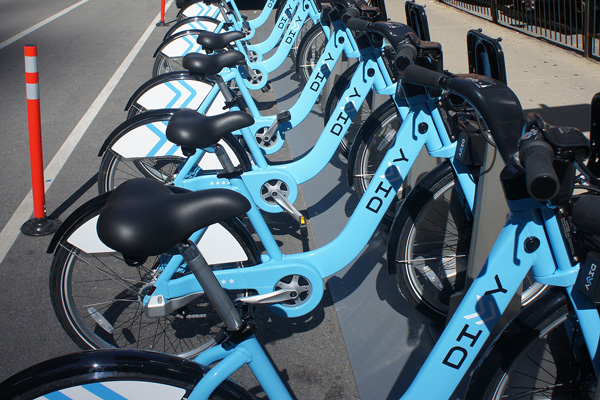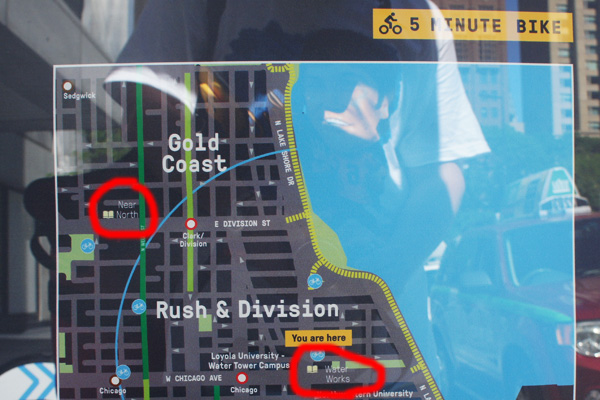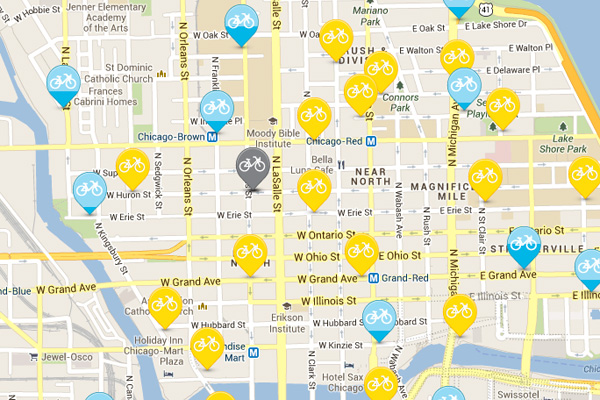
Photo: Whet Moser
While the rest of Chicago was queueing up for the Blackhawks parade—speaking of that, when they win next year, I suggest Chicago do what San Antonio did when the Spurs did in 2007, and draw attention to the riverwalk by sending the champs down it on (actual) floats—I was heading out to the nearest Divvy bike-share station to take a test ride on the new system, which debuted today.
Here's how it works. You insert your card (the kiosks look a lot like the new parking meters), enter your phone number and zip code, agree to the TOS, and you're given a code to unlock a bike. For $7, you have a half-hour to ride that bike before docking it; if you go over that, it's a $2 charge for the next half hour, and goes up after that.
But you can dock the bike, get a new code, and the clock starts over; $7 buys you unlimited rides as long as you dock the bike every half-hour.
Here's what the ride on the Divvy was like. [Update: At WBEZ, Robin Amer has a review; she had some technical problems. You do have to be careful to dock the bike in the station; getting it in and out takes a little getting used to.]
The Bike:
It's big, heavy, and has three gears and a wide turning radius. It will not go very fast. I didn't have a bike computer handy, but I think I got it up to about 15 mph. That's okay, though; right now almost all of the stations are in pretty dense neighborhoods concentrated around the Loop. There are lots of lights, stop signs, turning cars, and slow traffic, so you're not going to be able to go very fast for very long anyway. You'll probably spend most of your time in second and third gear. First didn't seem to do much, besides combine a spinning workout with a grindingly slow commute.
They've got fenders to keep dirt off your clothes, and chainguards to keep grease off your pants (I've ruined a couple pairs that way). The most pleasant surprise was the front basket. I was dreading having to sling my bag around my shoulder, but the basket is wide enough to cram a decent-sized messenger bag into, and has a strap to secure it. If your bag's not bulky, you can fit a change of clothes, smallish electronics, and lunch on board.
The brakes on both bikes were nice and tight; the seat post is easy to adjust, and it's numbered so you can set it to your height before you take the bike out. They've got a bell (use it if you're passing another cyclist), and front and rear lights.
Getting Around:
Checking out the bike is fast; checking out a new one is faster. The kiosks have maps, with some points of interest, bike lanes, one-way street directions, and a radius suggesting how far you can go in five minutes. The maps note where the libraries are, which, thumbs up; someone knows their audience.

There's no mobile app, which would be nice, something to tell you where the nearest dock is to your location. But the mobile Divvy page works well, as does the mobile-page map, which is easy enough to use on a phone.
[Update: I'm told that CycleFinder works with Divvy and a lot of other bikeshare programs—here's the iTunes link, and there's an Android app—but my phone is being recalcitrant so I can't test it yet.]
The station map shows where the existing and coming-soon docks are, and shows how many bikes are available at a given location. So you can also get a sense of how many bikes are being used at what stations, if you're interested in that sort of thing.

Until there's a mobile app, it's worth keeping in your head where the nearest station is to where you're going, especially if you're riding around one-way streets in River North. "Around Water Tower" was not sufficient for my needs. The map shows traffic-direction arrows, which is extremely useful; it would be nice if it showed bike lanes.
If you're unaccustomed to biking downtown, it's not as bad as you might think. Lots of people ride on Michigan Avenue; there's a lot of traffic on it, but very little parking; since car doors somewhat non-intuitively tend to be a bigger risk than moving cars, riding Michigan is less stressful than it seems. If you live or work downtown, even if you've never biked, you probably have a sense of what streets are particularly congested and which ones tend to have the worst drivers.
Given the target audience for Divvy, I don't expect a lot of users to be speed demons, but its weight and lack of nimbleness will keep that in check. It's the bike equivalent of a 1990s minivan; not only is it virtually impossible to go hell for leather on it, you'd feel kind of silly doing it. This should be good news for drivers as well; those who are worried about Divvy unleashing a wave of car-slaloming dudes on city streets can rest in the knowledge that doing anything but going straight and taking wide turns at a moderate pace is not remotely worth it.
Tips:
Pack a handkerchief. If you're like me, you'll go from feeling blissed-out, wind flowing through your helmet, to sweating like a stuck pig once you go inside. Actually, you probably don't sweat as much as me, but it's still useful. A water bottle's nice too. I hear tell that baby wipes are handy but I'm not that organized.
Be considerate to drivers. Save for Lake Shore at night, driving downtown's no fun; no reason to make anyone's day worse. One of the theories for why drivers are sometimes hostile to cyclists—and it doesn't happen that much to me, really—is fear. For obvious reasons, hitting a cyclist is a much scarier proposition than hitting another car.
Use arm signals. Not just so drivers will know what you're doing, but other cyclists as well.
You're allowed to be there: "Bicyclists riding on a highway are granted all the rights and are subject to all of the duties applicable to the driver of a vehicle, with certain exceptions." You're allowed to take the lane when you need to—for example, when there's a car or truck stopped in the bike lane, signal and make sure you've got an opening, and go around.
Turning left in traffic: There are two ways of doing this. You can do it like you're driving a car: signal left, and cross into the left lane or the left side of a single lane. It's legal, but depending on your confidence level it can feel hairy. If so, you can do a pedestrian turn: ride through the street on the right side, stop on the other side, then turn and go when you have the green.
Winter biking. Biking 20 minutes with gloves and a balaclava involves less bone-chilling misery than standing still for 10 minutes waiting for the bus.
Verdict:
So far, it's promising. After a couple rides I'm more tempted to sign up, even though it doesn't make a lot of sense for me. If you have a commute of 1-3 miles, whether from home or the Metra, it's much cheaper than the CTA: $75 a year for unlimited rides compared to $1,200 a year for an unlimited CTA pass. Even if you only use it to replace the CTA for couple temperate months a year, it's cheaper.
And in some ways, it's cheaper than owning a bike. If you're lucky you can get a decent, functional bike for $75 or less, though it takes some effort; depending on how much maintenance you put into your bike and how much of it you do yourself, you might spend less than $75 a year. Divvy's $75 a year, no maintenance, no storage, no worries about having your bike stolen.
It all depends on what you're up to. If you want to ride outside of the central city, or carry more than a moderately-sized bag, or just want the pleasure of riding a fast, nimble bike, Divvy's not the solution. But for regular short commutes, downtown workers who want to bike but live in the suburbs, regular errands, or extending your lunch radius, it looks pretty effective.
And for the rest of the city, there will be benefits if people use it: taking some of the burden off overcrowded buses, lowering some of the cultural barriers to biking—showing that it's not just for messengers, speed demons on expensive road bikes, and "hipsters" on "fixies," as newspaper columnists seem to think—and, most importantly, getting more cyclists on the street, one of the most effective ways for making those streets safer for cyclists.


